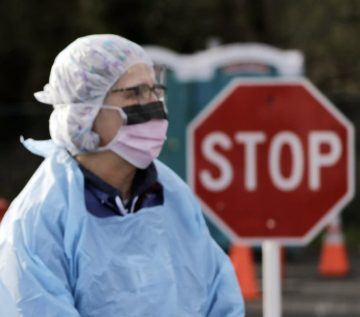Month: March 2020
Disease as Political Metaphor
Susan Sontag in NYRB (February 23, 1978):
 Punitive notions of disease have a long history, and such notions are particularly active with cancer. There is the “fight” or “crusade” against cancer; cancer is the “killer” disease; people who have cancer are “cancer victims.” Ostensibly, the illness is the culprit. But it is also the cancer patient who is made culpable. Widely believed psychological theories of disease assign to the ill the ultimate responsibility both for falling ill and for getting well. And conventions of treating cancer as no mere disease but a demonic enemy make cancer not just a lethal disease but a shameful one. Leprosy in its heyday aroused a similarly disproportionate sense of horror. In the Middle Ages the leper was a social text in which corruption was made visible; an exemplum, an emblem of decay. Nothing is more punitive than to give a disease a meaning—that meaning being invariably a moralistic one. Any important disease, whose physical etiology is not understood, and for which treatment is ineffectual, tends to be awash in significance. First, the subjects of deepest dread (corruption, decay, pollution, anomie, weakness) are identified with the disease. The disease itself becomes a metaphor. Then, in the name of the disease (that is, using it as a metaphor), that horror is imposed on other things. The disease becomes adjectival. Something is said to be disease-like, meaning that it is disgusting or ugly. In French, a crumbling stone façade is still “lépreuse.”
Punitive notions of disease have a long history, and such notions are particularly active with cancer. There is the “fight” or “crusade” against cancer; cancer is the “killer” disease; people who have cancer are “cancer victims.” Ostensibly, the illness is the culprit. But it is also the cancer patient who is made culpable. Widely believed psychological theories of disease assign to the ill the ultimate responsibility both for falling ill and for getting well. And conventions of treating cancer as no mere disease but a demonic enemy make cancer not just a lethal disease but a shameful one. Leprosy in its heyday aroused a similarly disproportionate sense of horror. In the Middle Ages the leper was a social text in which corruption was made visible; an exemplum, an emblem of decay. Nothing is more punitive than to give a disease a meaning—that meaning being invariably a moralistic one. Any important disease, whose physical etiology is not understood, and for which treatment is ineffectual, tends to be awash in significance. First, the subjects of deepest dread (corruption, decay, pollution, anomie, weakness) are identified with the disease. The disease itself becomes a metaphor. Then, in the name of the disease (that is, using it as a metaphor), that horror is imposed on other things. The disease becomes adjectival. Something is said to be disease-like, meaning that it is disgusting or ugly. In French, a crumbling stone façade is still “lépreuse.”
Epidemic diseases were a common figure for social disorder. From pestilence (bubonic plague) came “pestilent,” whose figurative meaning, according to the Oxford English Dictionary, is “injurious to religion, morals, or public peace—1513”; and “pestilential,” meaning “morally baneful or pernicious—1531.” Feelings about evil are projected onto a disease. And the disease (so enriched with meanings) is projected onto the world. In the past, such grandiloquent fantasies were regularly attached to the epidemic diseases, diseases that were a collective calamity. In the past two centuries, the diseases most often used as metaphors for evil were syphilis, tuberculosis, and cancer—all diseases imagined to be, preeminently, the diseases of individuals.
Syphilis was thought to be not only a horrible disease but a demeaning, vulgar one. Antidemocrats used it to evoke the desecrations of an egalitarian age.
More here. (NOTE: Thanks to Rima Zaheer from New Delhi)
Solitude And Loneliness
Terry Eagleton at The Guardian:
 Solitude is not the same as loneliness. Lonely people feel the need for company, while solitary types seek to escape it. The neatest definition of loneliness, David Vincent writes in his superb new study, is “failed solitude”. Another difference between the two groups is that hermits, anglers, Trappist monks and Romantic poets choose to be alone, whereas nobody chooses to feel abandoned and bereft. Calling yourself “self-partnering”, meaning that you sit in the cinema (should they be open) holding your own hand, may be either a genuine desire for solitude or a way of rationalising the stigma of isolation. The greatest difference of all, however, is that solitude has rarely killed anyone, whereas loneliness can drive you to the grave. As the coronavirus rampages, some of us might now face a choice between physical infection and mental breakdown.
Solitude is not the same as loneliness. Lonely people feel the need for company, while solitary types seek to escape it. The neatest definition of loneliness, David Vincent writes in his superb new study, is “failed solitude”. Another difference between the two groups is that hermits, anglers, Trappist monks and Romantic poets choose to be alone, whereas nobody chooses to feel abandoned and bereft. Calling yourself “self-partnering”, meaning that you sit in the cinema (should they be open) holding your own hand, may be either a genuine desire for solitude or a way of rationalising the stigma of isolation. The greatest difference of all, however, is that solitude has rarely killed anyone, whereas loneliness can drive you to the grave. As the coronavirus rampages, some of us might now face a choice between physical infection and mental breakdown.
more here.
An Attentive Memoir of Life in Parma
Patricia Hampl at The Paris Review:

Mother Tongue is “an American life,” as its subtitle says, lived in provincial, family-laden Parma (not international Rome, not the Amalfi coast, nor a restored Tuscan villa). This is a life knocked wonderfully off-balance (well, wonderful for the reader) to reveal an almost shockingly frank intelligence. A rare candor pervades and enlivens these chapters. No doubt its keen focus is bred of isolation, even loneliness. Such is exile. The job is to say what you see—inside and outside. It’s an act of faith in our supposedly faithless world.
The exile is not only geographic. It’s linguistic. This is an American writer; English is her business, but her life and the life around her is lived in Italian.
more here.
A Tale of Two Capitalisms
 Arthur Goldhammer reviews Branko Milanovic’s Capitalism Alone: The Future of the System that Rules the World over at Democracy:
Arthur Goldhammer reviews Branko Milanovic’s Capitalism Alone: The Future of the System that Rules the World over at Democracy:
In certain quarters of the United States it is taken for granted nowadays that capitalism has failed or at the very least fallen into desperate crisis, which will soon result in its replacement by “democratic socialism.” Branko Milanovic, who grew up under Tito’s brand of socialism in Yugoslavia, is impervious to such romantic fantasies. For him, capitalism is without question “the system that rules the world.” By this he means simply “that the entire globe now operates according to the same economic principle —production organized for profit using legally free wage labor and mostly privately owned capital, with decentralized coordination.” These criteria are met not only by what used to be called the “advanced industrial economies” of the West (plus Japan) but also by China, India, Russia, Brazil, Vietnam, and many other countries, which, taken together, account for the lion’s share of global production. This, says Milanovic, an economist who holds the Maddison Chair at the University of Groningen in the Netherlands in addition to being a senior scholar at LIS and former head of research at the World Bank, is a situation “without historical precedent.”
It would not have been possible to make this assertion before 1989 and the collapse of communism, which presented itself as a viable alternative to the capitalist organization of production. But if the economic system that has emerged since 1989 in much of the non-Western world can be described as capitalist, it is not capitalist in the same way as the West. For Milanovic, the cardinal fact about today’s all-conquering capitalism is that it comes in two distinct forms: “liberal meritocratic” in the West, primarily the United States, and “state-led political or authoritarian” in Asia, primarily in China. Both are “capitalist” in the spirit of the definition set forth above, but in other respects they differ sharply. And crucially, both differ from the capitalism that prevailed in the West from the end of World War II until the fall of communism, which the author calls “social-democratic capitalism.”
More here.
Declining worker power and American economic performance
 Anna Stansbury and Lawrence H. Summers (yes, that one!) over at Brookings:
Anna Stansbury and Lawrence H. Summers (yes, that one!) over at Brookings:
Increased monopoly power is commonly believed to explain the trends in labor income and corporate profits—but it is hard to reconcile with the substantial falls in average unemployment and inflation over the period, argue the authors, Anna Stansbury and Lawrence H. Summers of Harvard University. A decline in worker power can explain all these trends, they argue.
“Declining unionization, increasingly demanding and empowered shareholders, decreasing real minimum wages, reduced worker protections, and the increases in outsourcing domestically and abroad have disempowered workers with profound consequences for the labor market and the broader economy,” the authors write in Declining Worker Power and American Economic Performance.
If decreased worker power is a major cause of increasing inequality and lack of progress in labor income, then “it raises issues about the extent to which corporations should be run solely for the benefit of their shareholders” and “would suggest that policy should tip the balance more in the direction of supporting union organizing activities and empowering unions,” they write.
Against Productivity in a Pandemic
 Nick Martin in TNR:
Nick Martin in TNR:
This is a time to sustain. To find ease where we can in a world rapidly placing us into chaos. “We do not tend to see maintenance and care as productive in the same way,” Odell wrote. But we should.
This piece, the one you’re reading right now, took roughly an hour longer for me to write than it normally would have because I am currently sitting in my New York apartment thinking about a million different things: Are all my grandparents properly secluded? Is my extended family taking this seriously enough? Should I rent a car and drive home and get away from the city before it all really goes to hell? Are rental car companies going to be price gouging? When will the money from my canceled vacation return to my account? Did I order enough cat food? Do I have enough food? What will things look like two weeks from now? A year from now?
That is normal, now. That is the experience I am sharing with my friends and cousins and family and neighbors. While I’m still reading emails and scanning my drafts for revisions, my mind is miles away with the people that matter most to me. For those with the privilege and ability to conduct their work from home, the coming weeks should be a time to focus on ourselves, our communities, and our loved ones. It should be a time to do nothing and produce little without the accompanying feeling of guilt or panic caused by a ping from a higher-up that you should be doing more as the rest of your world slowly cranks to a halt.
More here.
This Is the One Thing That Might Save the World From Financial Collapse
 Adam Tooze in the NYT:
Adam Tooze in the NYT:
For the second time this century, the world is facing an acute shortage of dollar funding. This is a big problem: An enormous amount of global financial activity depends on the use of the dollar. If we are to contain the fallout from the crisis, America’s central bank must act as a lender of last resort not just to America’s financial system but also to the entire world’s.
The good news is that the Federal Reserve is taking its responsibility seriously: It is funneling dollars to central banks around the world. But is the Fed fighting the last war?
The question turns on what we mean by global finance. In 2008 the dollar shortage was confined largely to the banks of Europe and America. That is the Fed’s historic comfort zone, the cradle within which it was born a century ago. The coronavirus crisis explodes that 20th-century framework and poses the question: How does America’s central bank supply dollar liquidity to a polycentric world economy?
More here.
Social Europe: Gabe Zucman on the Triumph of Injustice
Donald Trump’s Cult of Personality Did This
Adam Serwer in The Atlantic:
 The president of the United States is a menace to public health.
The president of the United States is a menace to public health.
I don’t mean that I disagree with him on policy, although I do. I don’t mean that I abhor the president’s expressed bigotry toward religious and ethnic minorities, although that is also true. I am not referring to Donald Trump’s efforts to corrupt the Justice Department, shield his criminal associates from legal peril, or funnel taxpayer money to his tacky hotels and golf courses, although all of these things are reason enough to oppose the president.
What I am referring to is the fact that, soon after the coronavirus outbreak emerged in China, the rest of the world began to regard it as a threat to public health, while Trump has seen it as a public-relations problem. Trump’s primary method of dealing with public-relations problems is to exert the full force of the authoritarian cult of personality that surrounds him to deny that a problem even exists. This approach has paid political dividends for the Republican Party, in the form of judicial appointments, tax cuts for the wealthy, and a rapid erosion of the rule of law. But applied to the deadly pandemic now sweeping the planet, all it has done is exacerbate the inevitable public-health crisis, while leaving both the federal government and the entire swath of the country that hangs on his every word unprepared for the catastrophe now unfolding in the United States. The cardinal belief of Trumpism is that loyalty to Trump is loyalty to the country, and that equation leaves no room for the public interest.
Neither the tide of pestilence sweeping the nation nor the economic calamity that will follow was inevitable. They are the predictable outcomes of the president’s authoritarian instincts, his obvious incompetence, and the propaganda apparatus that has shielded him from accountability by ensuring that the public is blinded to his role in the scale of this disaster.
More here.
Philip Roth and American Manhood
Alex Perez in Tablet Magazine:
 The woke literati have trouble understanding how a Cuban American whose first language is Spanish can feel a deep kinship with writers like Richard Ford and Barry Hannah, a pair of Southerners who look absolutely nothing like me and certainly don’t sound like me, because they can’t comprehend that the Southern male experience and the Hispanic male experience—as well as most other male experiences—are more alike than not. I read Roth and Carver and the rest of the problematic male crew because, above all other contemporary classifications, I identify as a man. The fact that I was born to Cuban parents and live in a predominately Hispanic community has always been secondary to my maleness, which is why I so strongly connected and continue to connect with unabashedly masculine writers who tackle classically heterosexual male concerns. Questions of creed or color were never at the forefront for me, because to be a young man, for better or worse, is to be ruled by your manhood, which is why my main concerns as a reader and a writer have always been boyhood and manhood and all the permutations in between.
The woke literati have trouble understanding how a Cuban American whose first language is Spanish can feel a deep kinship with writers like Richard Ford and Barry Hannah, a pair of Southerners who look absolutely nothing like me and certainly don’t sound like me, because they can’t comprehend that the Southern male experience and the Hispanic male experience—as well as most other male experiences—are more alike than not. I read Roth and Carver and the rest of the problematic male crew because, above all other contemporary classifications, I identify as a man. The fact that I was born to Cuban parents and live in a predominately Hispanic community has always been secondary to my maleness, which is why I so strongly connected and continue to connect with unabashedly masculine writers who tackle classically heterosexual male concerns. Questions of creed or color were never at the forefront for me, because to be a young man, for better or worse, is to be ruled by your manhood, which is why my main concerns as a reader and a writer have always been boyhood and manhood and all the permutations in between.
It is this unabashed masculinity, and not whiteness, that my woke-reader friends find repellent, which explains their disgust at the mere mention of any of the great masculine writers. In their eyes, it is a great sin, no doubt, to be white, but to be a traditionally masculine man has seemingly trumped even whiteness as America’s greater cultural sickness. A white person afflicted by their terrible, repellent whiteness might possibly even be rehabilitated, but a masculine young man, irrespective of race, is inherently toxic.
Our experts and tastemakers seem to think that the attempted eradication of traditional masculinity will make for a healthier society—it won’t—but what happens to the young men who, instead of transcending their manhood, choose to understand it in the hope of harnessing its great potential?
More here.
Saturday Poem
Redbud
Flamingo-beaked buds open on bare branches.
Pollen-drunk, the long-tongued bees
mount bright blossoms.
Startled,
petals burst pink against a blue sky.
Only after the gaudy show—
tender leaves, red-rimmed, unfold,
grow into a heart.
Monarch Butterflies on Joe-Pye Weed
You cling to these late summer blossoms,
uncurl fine filaments, kneading, needing
sweet nectar for your flight. Hinged wings open
and close like ancient Chinese kites,
silk dyed tiger-bright, trimmed with black-ink
calligraphic designs. You feed and flutter,
then lift, tilt in the air, set sail – fragile prayers
flying to the gods. Safe journey.
by Suzanne Marshall
from EcoTheo Review
(Against) Virus as Metaphor
Paul Elie in The New Yorker:
 In retrospect—in the rueful retrospect we are living in already—we’ll say that the virus was there all along, in the circumstances that enabled it to spread. It was there in a globally integrated society of travel, work, and commerce, the connecting and conveying powers of which far outstripped the capacity of our health systems to deal with their effects and challenged our willingness to reckon with the downsides of such integration. But it was there, too, in the language and imagery of viruses, which has been commonplace in our society for a couple of decades now—so much so that the ubiquity of virus as metaphor may have left many of us unprepared to recognize and fear the lethal literal viruses circulating among us, and to prepare ourselves and our societies against them.
In retrospect—in the rueful retrospect we are living in already—we’ll say that the virus was there all along, in the circumstances that enabled it to spread. It was there in a globally integrated society of travel, work, and commerce, the connecting and conveying powers of which far outstripped the capacity of our health systems to deal with their effects and challenged our willingness to reckon with the downsides of such integration. But it was there, too, in the language and imagery of viruses, which has been commonplace in our society for a couple of decades now—so much so that the ubiquity of virus as metaphor may have left many of us unprepared to recognize and fear the lethal literal viruses circulating among us, and to prepare ourselves and our societies against them.
It was there in the computer virus: the notion that the snags and missed connections and bits of botched code in our computers behaved virally, spreading through the system, or the network, to countless individual machines. So we bought and installed virus-protection software and watched as it was updated, showing us, in a little onscreen box, how many tens of thousands of viruses it had successfully blocked.
More here.
Titian’s Late Pictures
Martin Gayford at The Spectator:
 To ‘review’ such supreme paintings is slightly absurd. These are the touchstones from which Rubens, Velazquez and Rembrandt learnt and their successors still do. Van Dyck actually owned ‘Perseus and Andromeda’; Lucian Freud confessed that he, too, would have liked to have had one of these Titians on his wall. He couldn’t choose between ‘Diana and Actaeon’ and ‘Diana and Callisto’, which he considered jointly ‘simply the most beautiful pictures in the world’.
To ‘review’ such supreme paintings is slightly absurd. These are the touchstones from which Rubens, Velazquez and Rembrandt learnt and their successors still do. Van Dyck actually owned ‘Perseus and Andromeda’; Lucian Freud confessed that he, too, would have liked to have had one of these Titians on his wall. He couldn’t choose between ‘Diana and Actaeon’ and ‘Diana and Callisto’, which he considered jointly ‘simply the most beautiful pictures in the world’.
Frank Bowling, a contemporary master of abstraction, returns again and again to ‘The Death of Actaeon’ — in part because he finds it so modern. ‘There’s something amazing in the stirring up of the paint,’ he told me. ‘It just comes across at you — whoosh! — like a De Kooning.’
more here.
Western Esotericism!
The Stonemasons
Will Wiles at Literary Review:
 There are few reading pleasures that compare with a passionate expert describing their work, and Ziminski stands proudly in this field. He is a mason working in the West Country, repairing and restoring prehistoric tombs, stone circles, Roman fragments and Christian churches, all the time trying to adopt the techniques used by the builders of these places. This has allowed him to construct an fascinating and idiosyncratic picture of English history. He travels by bicycle and boat and his mind wanders as he works, conjuring up with remarkable deftness disappeared English worlds and the ordinary people who lived in them. Envisaging the lives of forgotten builders – why they made the choices they did, how they lived, where they went – naturally entails a good deal of supposition, imagination and ‘must have beens’. But Ziminski’s speculations carry unusual authority, as he takes himself to the same places as them, performing the same tasks with the same tools and materials and facing the same problems.
There are few reading pleasures that compare with a passionate expert describing their work, and Ziminski stands proudly in this field. He is a mason working in the West Country, repairing and restoring prehistoric tombs, stone circles, Roman fragments and Christian churches, all the time trying to adopt the techniques used by the builders of these places. This has allowed him to construct an fascinating and idiosyncratic picture of English history. He travels by bicycle and boat and his mind wanders as he works, conjuring up with remarkable deftness disappeared English worlds and the ordinary people who lived in them. Envisaging the lives of forgotten builders – why they made the choices they did, how they lived, where they went – naturally entails a good deal of supposition, imagination and ‘must have beens’. But Ziminski’s speculations carry unusual authority, as he takes himself to the same places as them, performing the same tasks with the same tools and materials and facing the same problems.
more here.
In one Italian town, we showed mass testing could eradicate the coronavirus
Andrea Crisanti and Antonio Cassone in The Guardian:
 It’s now about one month since Covid-19 began to sweep across Italy. With more than total cases topping 40,000 as of 19 March, it is now the worst-affected country outside of China.
It’s now about one month since Covid-19 began to sweep across Italy. With more than total cases topping 40,000 as of 19 March, it is now the worst-affected country outside of China.
But in the last two weeks, a promising pilot study here has produced results that may be instructive for other countries trying to control coronavirus. Beginning on 6 March , along with researchers at the University of Padua and the Red Cross, we tested all residents of Vò, a town of 3,000 inhabitants near Venice – including those who did not have symptoms. This allowed us to quarantine people before they showed signs of infection and stop the further spread of coronavirus. In this way, we eradicated coronavirus in under 14 days.
While we believe it is too late to enact this approach in a city such as Milan, where infections are out of control, there could still be time to do this in the UK before the crisis gets even worse: the government could identify and isolate clusters, quarantine everyone affected, trace their recent contacts, and quarantine and isolate them, too – whether they had symptoms or not.
More here.
The Best-Case Outcome for the Coronavirus, and the Worst
Nicholas Kristof in the New York Times:
 Here’s the grimmest version of life a year from now: More than two million Americans have died from the new coronavirus, almost all mourned without funerals. Countless others have died because hospitals are too overwhelmed to deal adequately with heart attacks, asthma and diabetic crises. The economy has cratered into a depression, for fiscal and monetary policy are ineffective when people fear going out, businesses are closed and tens of millions of people are unemployed. A vaccine still seems far off, immunity among those who have recovered proves fleeting and the coronavirus has joined the seasonal flu as a recurring peril.
Here’s the grimmest version of life a year from now: More than two million Americans have died from the new coronavirus, almost all mourned without funerals. Countless others have died because hospitals are too overwhelmed to deal adequately with heart attacks, asthma and diabetic crises. The economy has cratered into a depression, for fiscal and monetary policy are ineffective when people fear going out, businesses are closed and tens of millions of people are unemployed. A vaccine still seems far off, immunity among those who have recovered proves fleeting and the coronavirus has joined the seasonal flu as a recurring peril.
Yet here’s an alternative scenario for March 2021: Life largely returned to normal by the late summer of 2020, and the economy has rebounded strongly. The United States used a sharp, short shock in the spring of 2020 to break the cycle of transmission; warm weather then reduced new infections and provided a summer respite for the Northern Hemisphere. By the second wave in the fall, mutations had attenuated the coronavirus, many people were immune and drugs were shown effective in treating it and even in reducing infection. Thousands of Americans died, mostly octogenarians and nonagenarians and some with respiratory conditions, but by February 2021, vaccinations were introduced worldwide and the virus was conquered.
I’ve been speaking to epidemiologists about their best- and worst-case scenarios to gauge what may lie ahead and see how we can tilt the balance. Let me start with the best case, since we could all use a dose of hope — which may even be therapeutic — before presenting a bleaker prognosis.
More here.
Cats and Dominos
This Side Of Paradise: A Letter From F. Scott Fitzgerald, Quarantined In The South Of France
Nick Farriella in McSweeney’s:
 Dearest Rosemary,
Dearest Rosemary,
It was a limpid dreary day, hung as in a basket from a single dull star. I thank you for your letter. Outside, I perceive what may be a collection of fallen leaves tussling against a trash can. It rings like jazz to my ears. The streets are that empty. It seems as though the bulk of the city has retreated to their quarters, rightfully so. At this time, it seems very poignant to avoid all public spaces. Even the bars, as I told Hemingway, but to that he punched me in the stomach, to which I asked if he had washed his hands. He hadn’t. He is much the denier, that one. Why, he considers the virus to be just influenza. I’m curious of his sources.
The officials have alerted us to ensure we have a month’s worth of necessities. Zelda and I have stocked up on red wine, whiskey, rum, vermouth, absinthe, white wine, sherry, gin, and lord, if we need it, brandy. Please pray for us.
More here.
